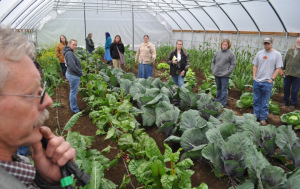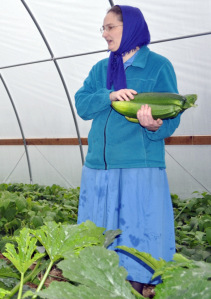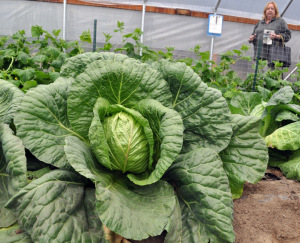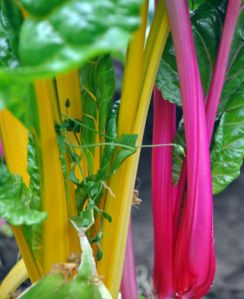Tunnel to growth — High tunnels
produce bountiful results

Tunnel to growth — High tunnels produce bountiful results
The short nails and calloused hands of Sterling resident Don Adams are an indication he is familiar with hard work. For him, an enjoyable weekend is spent feeling dirt sift through his fingers while tending to his crops.
The result of his hard work, and a little technology, are easily seen as Adams has Swiss chard that stands knee-high, cauliflower heads the size of cannon balls and corn stalks that rise as tall as he does. These, and numerous other crops, are all flourishing under his “high tunnel” — a plastic-covered structure with no electrical, heating or mechanical ventilation systems.
“I love it,” he said of his high tunnel, which stands 35 feet wide by 60 feet long and 16 feet tall. “Most of what’s in here I started from seed and only got in the ground the last week of July, so things grow really fast.”
 Unlike a traditional, heated greenhouse, a high tunnel system depends on just the plastic covering to raise temperatures within the structure, and keep
Unlike a traditional, heated greenhouse, a high tunnel system depends on just the plastic covering to raise temperatures within the structure, and keep
the soil and air warm for garden growing. Side vents that can be manually rolled up or down, and end doors that can be opened or shut provide ventilation and cooling when temperatures get too high.
“I came home the other day and it was 105 (degrees Fahrenheit) in here,” Adams said. “I opened it up, and a few minutes later it was 10 to 15 degrees cooler.”
The plastic covering to the high tunnel — a 6-mil, greenhouse-grade, UV-resistant polyethylene — holds in heat in Alaska’s warm-weather months, and Adams said the materials and the construction of the high tunnel are designed to endure the cold, too.
“The roof is guaranteed to hold 70 pounds per square foot.” Adams said. “The plastic may sag a bit under a snow load, but it won’t stretch or blow out, and it should tighten back up once the snow is off.”
Being able to sprout seeds in spring before outside temperatures are warm enough to even till the soil was the point of putting up the high tunnel, according to Adams.
“I wanted to extend my growing season, that was really the goal, but the weather is so adverse here,” he said. “The high tunnel should extend the growing season for crops by approximately two, three weeks on each end of the season, or possibly longer. Next year, I’m hoping the soil will be thawed
